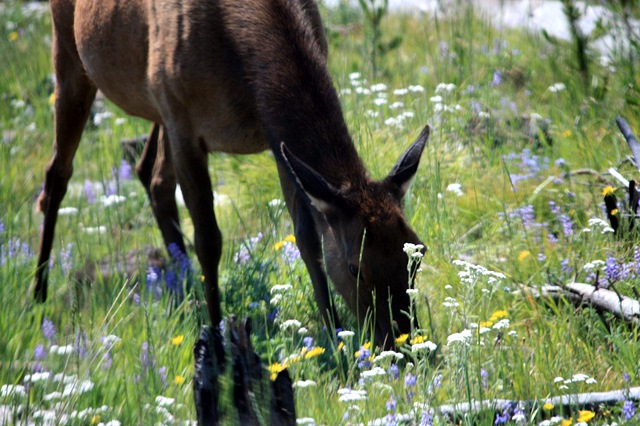This time we saw the bears only at a great distance and likewise the wolves. We heard of others seeing them-- when we had just left a place or hadn't gotten there. Fortunately, we have memories of other trips to help.
There are photos but you have to squint to recognize their shapes without seeing them move. If we had had a bigger telephoto, we'd have done better with the wolves. We are not professionals; paying $10,000 for that kind wasn't on our shopping list. I've read that some photograph through a scope and that might be something we can try next time.
One thing that never disappoints are the bison. The first time, over twenty years ago, when I saw the Lamar, I was amazed at the sight of the big herds. There aren't words to express what it feels like to see even a bit of the sort of thing the first explorers and settlers saw. There aren't many places to see free, wild herds. Yellowstone is one of them. This time, they were more broken into smaller herds and maybe that was the doing of park service to be easier on the grass or maybe it's their time with the young calves and this works best. Some breeding was going on, which tended to take the usual lone bulls away from their haunts to join the herds.
So these are our photos from July in the park. Some were right alongside the road-- sometimes on it...
It takes some doing to see the animals in these next photos. The first is a black bear going over the hill. Watching it through binoculars was clearer. The next was at the second kill we'd see at such a distance that you had to know it was there to see the wolves around it. Later the wolves appeared circle a bison and the antelope herd. The potential prey didn't seem worried.
I read about the alpha wolf in one of the packs having his jaw broken by either an elk or bison. He lost his position but was able to bring down an elk calf. He was unwilling to leave the carcass when another, more powerful pack came and they killed him. To live, some must die.
Second one taken with more powerful telephoto as were the following ones of the wolves, across the valley, trying to get their dinner.
To see wildlife in Yellowstone requires some patience, careful watching for movement, and luck. We saw a coyote pretty close also but couldn't get the camera up until it was over the hill. People share what they've seen and where. There is a lot of good feeling when in the wildlife areas. It's exciting to be even that close to wild things and their very real lives.






















4 comments:
Enjoyed your Yellowstone photos. Observing wild creatures, large or small, going about the business of their daily living is fascinating. We seem to be more curious about them than than they are us except for the occasional one.
I had a very close encounter years ago with a bear and two cubs in Wyoming while hiking on a trail just outside the town. The bear ignored us than goodness while we backed away. No bears on our recent Canada trip, but we were very careful.
Your photos are great, who cares if you're not a "pro". You have captured the feel of Yellowstone and some of it's wonder.
Every time I have been there it's been a new experience.
How amazing it must have been in the time of Lewis & Clark.
The lady at the Grizzly Wolf Discovery Center in West Yellowstone said bears dislike humans as we compete for the same food. In Yellowstone, the animals have no reason to be afraid of humans (buffalo have recently been culled and that might change), but most do avoid us. Maybe it's instinctual.
My husband had an encounter with a black bear and cubs when he was hunting one year. She reared up and then the cub ran off as she did. Most bears will avoid humans. We stay alert to what's around us and carry bear spray when we get away from the roads.
I can only imagine what it must have been like when the West was first seen-- even the differences in steams and rivers made by beaver, which the first trappers nearly took out with the societal desire for beaver fur. And those immense buffalo herds that were decimated to take down the great Native American tribes. I understand how so many animals, like the buffalo, wolves and grizzlies weren't compatible with settlements, ranching and farming. Still, it's neat to be somewhere they still have some of the feel of what it must have been. With Yellowstone, add to it the geyser basins for the energy of raw nature and it's not hard to see why it is so popular.
Post a Comment